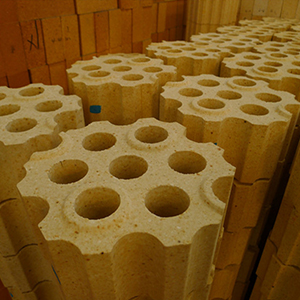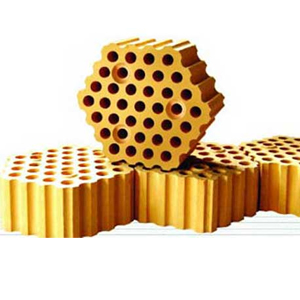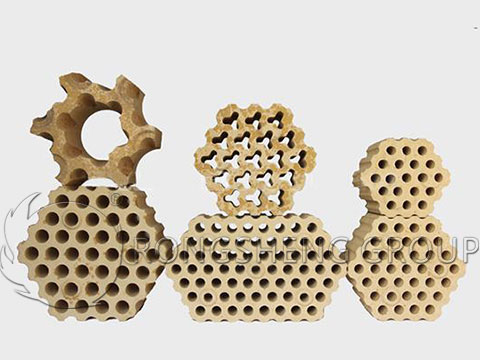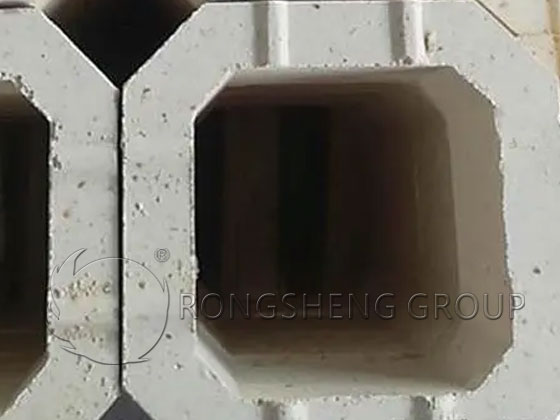Heat Storage Area Per Unit Volume of Hot Blast Furnace Checker Bricks
Refractory material manufacturer’s explanation of the heat storage area per unit volume of hot blast furnace checker bricks. Modern blast furnaces use regenerative hot blast furnaces, which are huge blast furnace blast heating facilities built up of checkered bricks. As a carrier of high-temperature heat, the working principle of checker bricks is to first burn gas, use the generated high-temperature flue gas to heat the checker bricks in the regenerator, and then pass the cold air through the hot checker bricks to be heated. The hot blast furnace alternately performs combustion and air supply, so that the blast furnace continuously obtains warm air. Therefore, improving the heat transfer efficiency of hot blast furnaces is of great significance to increasing the air temperature.

Heat Storage Area Per Unit Volume of Hot Blast Furnace Checker Bricks
To improve the heat transfer efficiency of the hot blast stove, the hot blast stove checker bricks must have excellent thermal properties. Using checker bricks in the design and increasing the thermal area of the checker bricks is an important technical measure to improve the heat transfer capacity. Comparison of the heat storage areas of several typical checker bricks below.
- Traditional 7-hole lattice brick. The grid hole diameter is 43mm and the heat storage area is 38.1m2/m3.
- 7-hole grid bricks. The diameter of the grid holes is 30mm, and the heat storage area is 47.08m2/m3.
- 19-hole grid brick. The grid hole diameter is 30mm and the heat storage area is 48.6m2/m3.
- 31-hole grid brick. The diameter of the grid holes is 25mm, and the heat storage area is 58.1m2/m3.
- 37-hole grid brick. The diameter of the grid holes is 20mm, and the heat storage area is 68.7 m2/m3.
The practice has proved that under basically the same conditions, the air temperature of a large blast furnace can be increased by 38°C when using 19-hole bricks with a diameter of 30mm compared with traditional 7-hole bricks with a diameter of 43mm. Using 31-hole bricks with a diameter of 25mm in small and medium-sized blast furnaces can increase the air temperature by 19°C compared with 9-hole bricks.
RS Refractory Material Manufacturer is a powerful refractory material manufacturer. The quality of our refractory products is reliable and guaranteed. And our comprehensive customer service can also provide reliable quality assurance for our refractory products. The description of the heat storage area per unit volume of hot blast furnace checker bricks can better help companies purchase suitable regenerator checker bricks.

Application and requirements of checker bricks in hot blast furnace regenerator
Choose the appropriate size and thickness of checker bricks. When choosing the shape of checker bricks and the type of checker bricks, the following conditions and requirements should be considered:
- ① The quality of refractory materials.
- ② The degree of gas cleaning.
- ③ Different temperature conditions between the upper and lower parts of the hot blast furnace checker bricks.
- ④ It has high heat transfer efficiency and can increase the hot air temperature in a guaranteed amount.
Selection of checkered bricks for hot blast furnace regenerator
The regenerator of the hot blast stove is a space filled with checker bricks. Its main function is to use the internal checker bricks to exchange heat with high-temperature flue gas and combustion air. Therefore, as a heat storage and heat transfer medium, checker bricks should have a large heating area, high thermal conductivity, and quality to facilitate heat exchange and heat storage.
The main method to increase the heating area is to increase the number of holes in the checker bricks per unit area, so the number of holes in the checker bricks in the regenerator tends to increase. To improve the thermal conductivity of the material, black silica bricks are commonly used in Europe as checker bricks inside the regenerator. Because the iron oxide content in black silica bricks is high, it has high density, high thermal conductivity, strong heat storage capacity, and high heat exchange efficiency. Therefore, the upper part of the regenerator is made of siliceous check bricks, the middle part of the regenerator is made of low-creep high alumina bricks, mullite bricks, sillimanite, andalusite bricks, etc., and the lower part of the regenerator is generally made of clay bricks.
Modern regenerative hot blast stoves can basically be divided into two major types. The hood-type check bricks have a constant cross-section throughout the entire height, and the multi-section check bricks have varying cross-sections. The latter can be divided into three types, namely checkered bricks with alternating cross-sections, core-filled bricks, and brick wall surfaces with different roughness. Checkered bricks are available in a variety of shapes, such as square, rectangular, round, hexagonal, etc.

1) Multi-section checkered bricks. It was more commonly used in the past. The checkered bricks of hot air stoves are also of this type. The points of multi-section grid bricks are as follows.
(1) When the quality of the refractory material is poor, the upper checker bricks are easily damaged due to high temperature. This difficulty can be overcome by increasing the diameter and thickness of the upper checker bricks. Increasing the checker brick diameter reduces heat transfer and therefore prevents the upper checker bricks from overheating. Increasing the thickness of the checker bricks can reduce the average temperature of the checker bricks so that the load softening point of the refractory bricks is not exceeded, which prevents the checker bricks from softening and deforming. To protect the checker bricks from having sufficient compressive strength, the thickness of the upper checker bricks should generally not be less than 50~60 mm.
By taking the above two measures, the wind temperature will not drop too much. Weakening the heat transfer effect of the upper checker bricks also means slowing down the cooling of the upper checker bricks themselves. Therefore, towards the end of the air supply stage, the outlet hot air temperature drops less. Additionally, thin bricks heat up quickly and cool down quickly. Therefore, increasing the thickness of the upper checker bricks can reduce the fluctuations in the temperature of the checker bricks themselves and the blast temperature.
(2) The temperature of the lower checkered bricks is low, the convective heat transfer effect is weakened, and the radiation heat transfer effect is also very small. Therefore, reducing the diameter of the lower checker bricks increases the airflow velocity accordingly, which can significantly improve the lower convection heat transfer effect. In addition, corrugated checker bricks and checker brick cores can also be used in the lower part. This not only increases the heating surface and reduces the diameter of the checker bricks, but also promotes turbulence in the airflow, which is conducive to convective heat transfer.
The lower checkered bricks should not be too thick. Because in the continuous alternation between the air supply period and the heating period of the hot blast stove, the temperature of the center of the lower checker brick rarely fluctuates and does not play a heat storage role. At the same time, thinning the lower checker bricks can also increase the heating area of the lower checker bricks. Therefore, the brick thickness of the lower checkered bricks is generally only 25~40 mm.
Generally speaking, when using ordinary clay bricks, multi-section checker bricks are in line with the temperature conditions and heat transfer laws in the furnace. And it can make the blast temperature drop less. However, it makes the cleaning operation of checkered bricks very difficult and prone to clogging.
2) Covered segmented checkered bricks. Recently, due to the continuous improvement of the quality of refractory materials and to avoid the difficulty of dust-cleaning operations, more and more cover-type checker bricks have been used. Although it does not comply with the rules of heat transfer, due to the use of high refractory materials, the entire checker brick can be made of smaller checker bricks and thinner brick thicknesses, which can also increase the heat transfer coefficient to make up for the shortcomings.
With the improvement of gas depressurization work, the checker bricks can be gradually reduced. At present, China generally uses 80×80 mm checkered bricks. To ensure sufficient mechanical strength, the thickness of checker bricks should not be less than 50 to 60 mm.

Construction of Checkered Bricks for Hot Blast Furnace
Before laying checkered bricks in a hot blast stove, the grates and supports must be inspected. When inspected by the wire drawing method, the surface flatness deviation of the upper surface of the grate should be 0~5mm. The allowable deviation between the center line of the grate grid holes and the designed position should be 0~3mm.
The shape and size deviation of checker bricks should be accepted according to the relevant provisions of the current industry standard “High Alumina Bricks for Hot Blast Stoves” YB/T5016. Before construction, the usage plan should be determined based on the random inspection records of the dimensions of the checker bricks. Porous lattice bricks with tongues on the upper and lower sides should be layered according to height.
The grid hole at the center point of the regenerator should be used as the benchmark for determining the horizontal cross-center line control line of the brick grid on each layer. Each layer of grid bricks should be laid according to this horizontal cross-center line, and the grid holes should be kept vertical. During brick grid construction, wooden scales can be used to control the brick grid at the same time. During construction, a central control line should be established inside the surrounding furnace walls. The misalignment between the upper and lower brick grids should not exceed 5mm.
The surface of the brick grid should be smooth. The displacement of the brick grid holes to the furnace grate grid holes should not exceed 10mm, the complete number of grid holes should be counted and concealed engineering records should be filled in.
Expansion joints should be left between the surrounding checkered bricks and the furnace wall according to design regulations and should be fixed with wooden wedges.
Anti-scaling measures should be taken during construction and the grid holes must not be blocked. After the brick lattice is laid, it should be cleaned and the lattice holes should be inspected. If the bright light of the electric lamp can pass through the grid hole, or if the inspection steel drill lowered from above with a rope can pass through the full height of the grid hole, the grid hole should be considered qualified. The number of blocked holes should not exceed 3% of the number of complete holes in the layer brick grid. When using porous lattice bricks with upper and lower groove tongues for construction, the hole-blocking rate of the brick lattice does not need to be an inspection item.
When the brick lattice uses porous lattice bricks with groove tongues on the upper and lower floors, the upper and lower floors should be built with staggered joints and expansion joints should be left between bricks according to design regulations. The surrounding checkered bricks should be pre-processed and the arrangement diagram should be drawn in sequence.
To purchase hot blast stove regenerator checker bricks, heat storage hole bricks, and high thermal conductivity bricks, please contact us. We can provide high-quality refractory lining material products for high-temperature industrial furnaces. Our perfect customer service can provide long-life refractory materials for your high-temperature industrial furnace linings to save production costs.